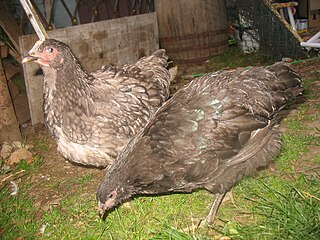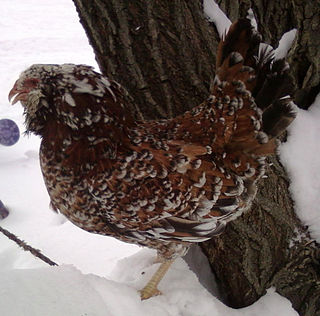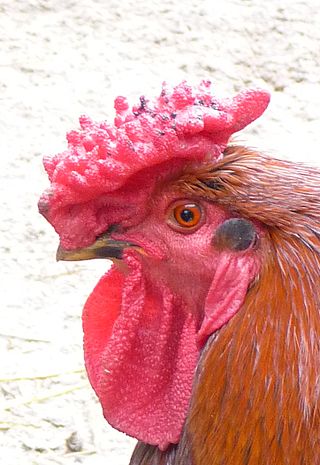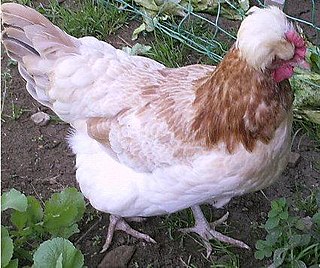
The Silkie is a breed of chicken named for its atypically fluffy plumage, which is said to feel like silk and satin. The breed has several other unusual qualities, such as black skin and bones, blue earlobes, and five toes on each foot, whereas most chickens only have four. They are often exhibited in poultry shows, and also appear in various colors. In addition to their distinctive physical characteristics, Silkies are well known for their calm, friendly temperament. It is among the most docile of poultry. Hens are also exceptionally broody, and care for young well. Although they are fair layers themselves, laying only about three eggs a week, they are commonly used to hatch eggs from other breeds and bird species due to their broody nature.

The Leghorn, Italian: Livorno or Livornese, is a breed of chicken originating in Tuscany, in central Italy. Birds were first exported to North America in 1828 from the Tuscan port city of Livorno, on the western coast of Italy. They were initially called "Italians", but by 1865 the breed was known as "Leghorn", the traditional anglicisation of "Livorno". The breed was introduced to Britain from the United States in 1870. White Leghorns are commonly used as layer chickens in many countries of the world. Other Leghorn varieties are less common.

The Dorking is a British breed of domestic chicken. It is named after the town of Dorking, in Surrey in southern England.

The Cochin is a breed of large domestic chicken. It derives from large feather-legged chickens brought from China to Europe and North America in the 1840s and 1850s. It is reared principally for exhibition. It was formerly known as Cochin-China.

The Brahma is an American breed of chicken. It was developed in the United States from birds imported from the Chinese port of Shanghai, and was the principal American meat breed from the 1850s until about 1930.

The Sussex is a British breed of dual-purpose chicken, reared both for its meat and for its eggs. Eight colours are recognised for both standard-sized and bantam fowl. A breed association, the Sussex Breed Club, was organised in 1903.

The Wyandotte is an American breed of chicken developed in the 1870s. It was named for the indigenous Wyandot people of North America. The Wyandotte is a dual-purpose breed, kept for its brown eggs and its yellow-skinned meat. It is a popular show bird, and has many color variants. It was originally known as the American Sebright.

The Ancona is a breed of chicken which originated in the Marches, region of Italy, but which was bred to its present type mainly in the United Kingdom in the nineteenth century. It is named after the city of Ancona, capital of the Marche. It is popular in Britain and the United States, but uncommon in Italy; an initiative to re-establish it in its native area and preserve its biodiversity was launched in 2000. There are also Ancona bantams.
The Croad Langshan is an old, heavy, soft-feathered chicken breed which probably originated in China.

The New Hampshire Red or New Hampshire is an American breed of chicken. It was developed in the early twentieth century in the state of New Hampshire by selective breeding of Rhode Island Red stock; no other breed was involved. It is fast-growing, early-maturing, quick-feathering, and yields a meaty carcase. Mature birds are a light or medium red in color; they may fade in sunlight.

The Jersey Giant is an American breed of domestic chicken. It was created in Burlington County, New Jersey, in the late 19th century. As the name suggests, it is a large breed, and is among the heaviest of all chicken breeds.

The Norfolk Grey is a utility breed of chicken that originated near the city of Norwich, in Norfolk, England, in around 1910. The breed was originally created by Frederick W Myhill of Hethel, Wymondham under the name Black Maria. It is a rare breed which is currently considered to be at risk by the Rare Breeds Survival Trust.

The Sebright is a British breed of bantam chicken. It is a true bantam – a miniature bird with no corresponding large version – and is one of the oldest recorded British bantam breeds. It is named after Sir John Saunders Sebright, who created it as an ornamental breed by selective breeding in the early nineteenth century.

The Houdan or Poule de Houdan is an old French breed of domestic chicken. It is named for its area of origin, the commune of Houdan, in the département of Yvelines to the west of Paris. It belongs to the crested chicken group, is muffed and bearded, has an unusual leaf-shaped comb, and has five toes on each foot rather than the usual four.

The Buckeye is an American breed of chicken. It was created in Ohio in the late nineteenth century by Nettie Metcalf. The color of its plumage was intended to resemble the color of the seeds of Aesculus glabra, the Ohio Buckeye plant for which the state is called the 'Buckeye State'.

The Java is a breed of chicken originating in the United States. Despite the breed's name, a reference to the island of Java, it was developed in the U.S. from chickens of unknown Asian extraction. It is one of the oldest American chickens, forming the basis for many other breeds, but is critically endangered today. Javas are large birds with a sturdy appearance. They are hardy, and are well-suited for both meat and egg production, especially by small-scale farms, homesteads, and backyard keepers.

The Orloff is a breed of chicken named after Alexei Grigoryevich Orlov, a Russian Count. Reflecting this origin, it is sometimes called the Russian Orloff or simply Russian.

The Derbyshire Redcap is a breed of chicken originating in the English county of Derbyshire. The name "Redcap" derives from the breed's unusually large Rose-type comb. British breed standards dictate a length of more than 7 centimetres (3 inches) of length for a Redcap comb. It is covered in small, fleshy points, and has a distinct spike pointing backwards called a "leader". Combs, wattles and earlobes are all ideally bright red.

The Sulmtaler is an Austrian breed of domestic chicken. It originates in the Sulmtal, the valley of the Sulm river, in southern Styria, in the south-east of Austria, and takes its name from that valley.


















